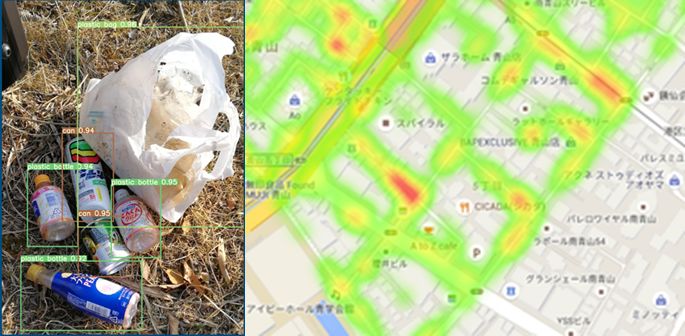トピックス Topics
Citizens help to assess plastic waste on land
New project uses crowdsourced photos and AI to assess the mass of plastic waste dumped in cities and on beaches 2022.03.11Topics

- Of all the plastic waste in the ocean, 80% is thought to have been originally discarded on land. But assessing the total quantity and weight of plastic waste discarded in cities and on beaches and calculating what percentage ends up in the ocean is difficult.
- Kyushu University has begun a proof-of-concept trial for analyzing litter data by working with Pirika Inc., a social business using technology to end the waste crisis. The study is being conducted in collaboration with Kagoshima University, the Japan Agency for Marine-Earth Science and Technology (JAMSTEC).
- This citizen science project is scheduled to run from January 2022 through the end of March 2025 and aims to establish a system for conducting ongoing quantitative surveys of mismanaged plastic on land.
- The smartphone app is available in multiple languages, including English, Chinese, Thai, and Japanese.
Using crowdsourced images, a new research project led by Kyushu University, Kagoshima University, JAMSTEC, and Pirika Inc. aims to calculate the total volume of plastic waste found on city streets and beaches.
The project leverages the free smartphone app Pirika, developed by Pirika Inc., which allows community members to upload pictures of plastic waste in the city or on the beach. These images, along with a timestamp and their location information, are then sent to Kagoshima University and JAMSTEC.
Using deep learning, the researchers are automating the identification and categorization of the type of plastic waste in the images—such as plastic bottles and plastic bags—and calculating the amount of area it covers. Collecting a large amount of image data will allow the team to assess the amount of plastic waste by type and track its change over time in more detail than ever before.
The Pirika smartphone app can be downloaded from the Pirika Inc. website. The app is currently available in Japanese and English, with a Thai version expected to be released by the end of the 2021 fiscal year.
“This project allows anyone to use their smartphone to participate in marine plastic pollution research, and we will share our findings with the world on the Pirika Inc. website,” explains Professor Atsuhiko Isobe of Kyushu University’s Research Institute for Applied Mechanics, one of the leaders of the part of the project. “We hope that the big data generated through this crowdsourced project will help accelerate the development of our research.”
The team is also led by Associate Professor Shin'ichiro Kako of the Kagoshima University Graduate School of Science and Engineering and Researcher Daisuke Matsuoka of the JAMSTEC Research Institute for Value-Added-Information Generation (VAiG), together with Pirika Inc. (Shibuya, Tokyo; President: Fujio Kojima).
This project is supported by a grant of the Japan Science and Technology Agency (JST) and Japan International Cooperation Agency (JICA) program SATREPS (“Formation of a Center of Excellence for Marine Plastic Pollution Studies in the Southeast Asian Seas,” Principal Investigator: Isobe) and a grant from the Ministry of the Environment ("Systematic elucidation of the Dynamics and Environmental Impact of Marine Plastic Pollution and the Advancement of Measurement Methods," Principal Investigator: Isobe).
Contact
Atsuhiko Isobe, Professor
Research Institute for Applied Mechanics, Kyushu University
TEL: 092-583-7726
FAX: 092-573-1996
Mail: aisobe★riam.kyushu-u.ac.jp
Please replace ★ with @































